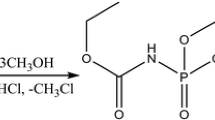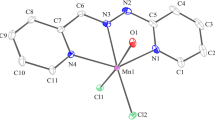Abstract
A series of five chloride coordination compounds of diethyl (pyridin-4-ylmethyl)phosphate (4-pmOpe) ligand, i.e. [CuCl2(4-pmOpe)2], [NiCl2(4-pmOpe)4], [CoCl2(4-pmOpe)], [ZnCl2(4-pmOpe)2], and [CdCl2(4-pmOpe)2], was prepared and studied. Stoichiometry and stereochemistry of the compounds was confirmed by spectroscopic and magnetic studies as well as by elemental analyses. The 4-pmOpe ligand has a capacity to coordinate to metal ions by means of phosphoryl oxygen and/or nitrogen of pyridine atoms. In Cu(II), Ni(II), and Zn(II) compounds, 4-pmOpe adopts the monodentate coordination mode, bonding metal centers through the pyridine nitrogen atom only. On the contrary, in Co(II) and Cd(II) compounds, 4-pmOpe acts as N,O-bridging ligand forming polynuclear structures. Magnetic studies (1.8–300 K) indicate mononuclear structure of the Co(II) and Ni(II) compounds and suggest existence of a very weak exchange coupling between metal centers in crystal lattice.
Similar content being viewed by others
References
Behrens, N. B., Goodgame, D. M. L., & Warnke, Z. (1978). Complexes of 9-methyladenine with some divalent metal halides. Inorganica Chimica Acta, 31, 257–261. DOI: 10.1016/S0020-1693(00)95012-6.
Boca, R. (2004). Zero-field splitting in metal complexes. Coordination Chemistry Reviews, 248, 757–815. DOI: 10.1016/j.ccr. 2004.03.001.
Carlin, R. L. (1986). Magnetochemistry. Heidelberg, Germany: Springer-Verlag.
El-Dissouky, A., & Refaat, L. S. (1984). Metal chelates of heterocyclic nitrogen-containing ketones. XIV. Metal ion, anion and substituent effects on the enolization of mono-keto compounds. Inorganica Chimica Acta, 87, 213–222. DOI: 10.1016/S0020-1693(00)81839-3.
Ferraro, J. R. (1971). Low frequency vibrations of inorganic and coordination compounds. New York, NY, USA: Plenum press.
Figgis, F. N., & Levis, J. (1964). The magnetic properties of transition metal complexes. In F. A. Cotton (Ed.), Progress in inorganic chemistry (Vol. 6, pp. 37–239). Hoboken, NJ, USA: Wiley. DOI: 10.1002/9780470166079.ch2.
Ginsberg, A. P., Martin, R. L., Brookes, R.W., & Sherwood, R. C. (1972). Magnetic exchange in transition metal complexes. IX. Dimeric nickel(II)-ethylenediamine complexes. Inorganic Chemistry, 11, 2884–2889. DOI: 10.1021/ic50118a006.
Kahn, O. (1993). Molecular magnetism. New York, NY, USA: VCH Publishers.
Kalinowska, U., Chęcińska, L., Małecka, M., Erxleben, A., Lippert, B., & Ochocki, J. (2005a). Synthesis and spectroscopy of diethyl (pyridinylmethyl)phosphates and their palladium (II) complexes: X-ray crystal structures of Pd(II) complexes. Inorganica Chimica Acta, 358, 2464–2472. DOI: 10.1016/j.ica.2005.02.020.
Kalinowska, U., Matławska, K., Chęcińska, L., Domagała, M., Kontek, R., Osiecka, R., & Ochocki, J. (2005b). Synthesis, spectroscopy and antiproliferative activity of cisand trans-platinum(II) complexes with diethyl (pyridin-4-ylmethyl)phosphate. X-ray crystal structure of trans-Pt(II) complex. Journal of Inorganic Biochemistry, 99, 2024–2031. DOI: 10.1016/j.jinorgbio.2005.06.030.
König, E. (1966). Magnetic properties of coordination and organometallic transition metal compounds. Berlin, Germany: Springer-Verlag.
Lever, A. B. P. (1968). Electronic spectra of some transition metal complexes: Derivation of Dq and B. Journal of Chemical Education, 45, 711–712. DOI: 10.1021/ed045p711.
Lever, A. B. P. (1986). Inorganic electronic spectroscopy. Amsterdam, The Netherlands: Elsevier.
Nakamoto, K. (1997). Infrared and Raman spectra of inorganic and coordination compounds. New York, NY, USA: Wiley.
Ochocki, J., Kostka, K., Żurowska, B., Mroziński, J., Gałdecka, E., Gałdecki, Z., & Reedijk, J. (1992). Synthesis, spectroscopy and magnetism of transition-metal complexes with pyridylmethylphosphonate ligands. Journal of the Chemical Society, Dalton Transactions, 1992, 2955–2960. DOI: 10.1039/DT9920002955.
Ochocki, J., Zurowska, B., Mroziński, J., Kooijman, H., Spek, A. L., & Reedijk, J. (1998). Synthesis, spectroscopy, and magnetic properties of transition-metal complexes with the diethyl 2-quinolylmethylphosphonate (2-qmpe) ligand — crystal structures of [Ni(2-qmpe)4(H2O)2](ClO4)2 and [Mn(2-qmpe)4(H2O)2](ClO4)2 showing unexpected O-binding of the qmpe ligands. European Journal of Inorganic Chemistry, 1998, 169–175. DOI: 10.1002/(SICI)1099-0682(199802)1998:2 〈169::AID-EJIC169〉3.0.CO;2-9.
Ochocki, J., Żurowska, B., Mroziński, J., & Reedijk, J. (1991). Structure and magnetism of the biologically active Co(II), Ni(II) and Cu(II) complexes with the pyridylmethylphosphonic acids: Synthesis, magnetism and spectroscopy of M(ED-2-PMPE)2Cl2. In Proceedings of the IIIrd Symposium on Inorganic Biochemistry and Molecular Biophysics and VIth International Scientific School on Biological Macromolecules, 15–21 September 1991 (pp. 211–212). Wrocław-Karpacz, Poland.
O’Connor, C. J. (1982). Magnetochemistry-advances in theory and experimentation. In S. J. Lippard (Ed.), Progress in inorganic chemistry (Vol. 29, pp. 203–283). Hoboken, NJ, USA: Wiley. DOI: 10.1002/9780470166307.ch4.
Reedijk, J., van Leeuwen, P. W. N. M., & Groeneveld, W. L. (1968). A semi-empirical energy-level diagram for octahedral, nickel(II) complexes. Recueil des Travaux Chimiques des Pays-Bas, 87, 129–143. DOI: 10.1002/recl.19680870203.
Schuitema, A. M., Engelen, M., Koval, I. A., Gorter, S., Driessen, W. L., & Reedijk, J. (2001). New didentate bispyrazole ligands forming uncommon eight-ring chelates with divalent copper, zinc and cobalt. Inorganica Chimica Acta, 324, 57–64. DOI: 10.1016/S0020-1693(01)00500-X.
Sigel, H., & Kapinos, L. E. (2000). Quantification of isomeric equilibria for metal ion complexes formed in solution by phosphate or phosphonate ligands with a weakly coordinating second site. Coordination Chemistry Reviews, 200–202, 563–594. DOI: 10.1016/S0010-8545(00)00307-6.
Smart, J. S. (1966). Effective field theories of magnetism. London, UK: Saunders.
West, D. X., & Hartley, R. J. (1980). Cu(II) complexes of N-methyl-2-picolinamine N-oxide. Journal of Inorganic and. Nuclear Chemistry, 42, 1141–1144. DOI: 10.1016/0022-1902(80)80425-8.
Żurowska, B., & Brzuszkiewicz, A. (2008). Co(II)-promoted transformation of diethyl(quinolin-2-ylmethyl)phosphonate to quinoline-2-carboxylate (2-qca): Synthetic, structural and magnetic studies of [Co(2-qca)2(EtOH)2]. Polyhedron, 27, 1623–1630. DOI: 10.1016/j.poly.2008.01.028.
Żurowska, B., Kalinowska-Lis, U., Białońska, A., & Ochocki, J. (2008). Coordination properties of diethyl (pyridin-2-ylmethyl)phosphate (2-pmOpe) ligand with perchlorate transition metal salts: Crystal structure of [Co(2-pmOpe)2 (H2O)2](ClO4)2. Journal of Molecular Structure, 889, 98–103. DOI: 10.1016/j.molstruc.2008.01.024.
Żurowska, B., Kalinowska-Lis, U., Brzuszkiewicz, A., & Ochocki, J. (2009). Spectroscopic and magnetic properties of diethyl (pyridin-4-ylmethyl)phosphate (4-pmOpe) ligand with perchlorate transition metal salts. Crystal structure of [Cu(4-pmOpe)2(ClO4)2]. Inorganica Chimica Acta, 362, 1435–1440. DOI: 10.1016/j.ica.2008.07.001.
Żurowska, B., Mroziński, J., Ciunik, Z., & Ochocki, J. (2007a). Coordination properties of the diethyl 2-pyridylmethylphosphonate ligand (2-pmpe) with chloride transition-metal salts: X-ray crystal structure of Cd4(2-pmpe)4Cl8. Journal of Molecular Structure, 843, 26–31. DOI: 10.1016/j.molstruc.2006.12.024.
Żurowska, B., Mroziński, J., Ciunik, Z., & Ochocki, J. (2006). Crystal structure, spectroscopic and magnetic properties of 2D network high-spin cobalt(II) complex with diethyl 2-pyridylmethylphosphonate. Journal of Molecular Structure, 791, 98–105. DOI: 10.1016/j.molstruc.2006.01.011.
Żurowska, B., Mroziński, J., & Ochocki, J. (2007b). Coordination properties of the diethyl 2-quinolilmethylphosphonate ligand with chloride and nitrate transition-metal salts. Materials Science-Poland, 25, 1063–1074.
Żurowska, B., Mroziński, J., & Ochocki, J. (1992). The IR spectra of the perchlorate compounds of Co(II), Ni(II) and Cu(II) with pyridylmethylphosphonate ligands. Materials Science-Poland, XVIII, 23–28.
Żurowska, B., Ochocki, J., Mroziński, J., Ciunik, Z., & Reedijk, J. (2004). Synthesis, spectroscopic and magnetostructural evidence forthe formation of Cu(II) complexes of pyridyl-2carboxylate (2-pca) and quinolyl-2-carboxylate (2-qca) as a result of a novel oxidative P-dealkylation reaction of diethyl 2-pyridylmethylphosphonate (2-pmpe) and diethyl 2-quinolylmethylphosphonate (2-qmpe) ligands. Inorganica Chimica Acta, 357, 755–763. DOI: 10.1016/j.ica.2003.06.017.
Author information
Authors and Affiliations
Corresponding author
Rights and permissions
About this article
Cite this article
Kalinowska-Lis, U., Żurowska, B. & Ochocki, J. Spectroscopic and magnetic evidence of coordination properties of bioactive diethyl (pyridin-4-ylmethyl)phosphate ligand with chloride transition-metal ions. Chem. Pap. 65, 660–666 (2011). https://doi.org/10.2478/s11696-011-0056-8
Received:
Revised:
Accepted:
Published:
Issue Date:
DOI: https://doi.org/10.2478/s11696-011-0056-8




